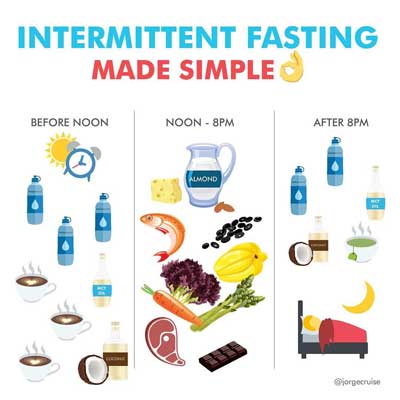Choose between the “16:8” or “2:5” intermittent fasting method and go for adapted food.
As soon as the warm season begins, a look in the full-body mirror becomes critical - and the trend towards fasting becomes popular again. Surprisingly, also some types of fat can help us in this process of getting slimmer...
When it comes to fasting, the so-called "intermittent fasting" is currently very much in vogue.
Instead of having to adhere to strict dietary rules for weeks on end - and then possibly falling into the dreaded yoyo effect afterwards - interval fasting involves daily meal breaks or whole fasting days per week. In this way the body “learns” to live on its fat reserves.
In addition, new studies show an even more far-reaching positive effect of intermittent fasting: biorhythm, insulin and glucose levels and intestinal flora normalize. Cholesterol, interleukins, triglycerides and inflammation markers in the blood decrease. Thus, interval fasting helps against obesity, cardiovascular diseases and type 2 diabetes.
Depending on what type you are and what your daily routine is, you can choose between two rhythms. In the “16:8” variant, you pause with your food intake for 16 hours overnight by either skipping the early or the late meal (as an example 16-8 o'clock or 18-10 o'clock or 20-12 o'clock, etc.) and eating normally for the remaining 8 hours.
With the 5:2 method you may eat as usual five days a week, but on two days you limit your calory intake to about 500-600 (women) and 600-850 (men). It is important that you really do not consume any calories (neither snacks nor alcohol) and drink enough during meal breaks. Allowed are water, unsweetened tea and black coffee (in moderation).
Already after a short time the body's metabolic processes are stimulated and you feel healthier, more comfortable and more energetic.
The consumption of certain fats is also important in this context. The thesis that fat is the main cause of overweight and various diseases of old age is outdated. The general recommendation to eat a low-fat diet, while not fundamentally wrong, is far too sweeping.
Fat is one of the three substances that are vital to us, but it depends on which fat we consume and in what form. A good example of healthy, tasty food is the so-called Mediterranean diet, where fat accounts for around 40% of calories. However, it uses hardly any animal fat but almost exclusively natural (virgin) olive oil. Virgin olive oil has been proven to drastically reduce the risk of having a stroke or breast cancer.
Oils and fats, on the other hand, should never be hydrogenated, because their trans fatty acids promote metabolic disorders and heart disease. In contrast, native rapeseed, walnut and olive oil contain the healthy omega-3 and omega-6 fatty acids that are also found in fatty sea fish. These oils, fresh vegetables, salad, pulses, seasonal fruit and fish twice a week are still the ideal diet for a long and healthy life.
(Edited from article by Heike Bludau)
Michel Robeers

